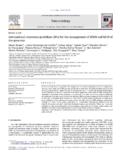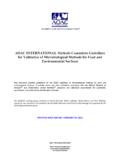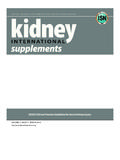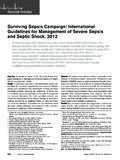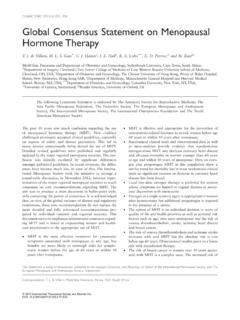Transcription of Updated International Consensus Guidelines on the ...
1 SPECIAL FEATURE. Updated International Consensus Guidelines on the Management of cytomegalovirus in Solid-Organ Transplantation sberg,4. Camille N. Kotton,1,8 Deepali Kumar,2 Angela M. Caliendo,3 Anders A. 5 6 7. Sunwen Chou, Lara Danziger-Isakov, and Atul Humar, on behalf of The Transplantation Society International CMV Consensus Group cytomegalovirus (CMV) continues to be one of the most common infections after solid-organ transplantation, resulting in significant morbidity, graft loss, and adverse outcomes. Management of CMV varies considerably among transplant centers but has been become more standardized by publication of Consensus Guidelines by the Infectious Diseases Section of The Transplantation Society. An International panel of experts was reconvened in October 2012. to revise and expand evidence and expert opinion-based Consensus Guidelines on CMV management, including di- agnostics, immunology, prevention, treatment, drug resistance, and pediatric issues. The following report summarizes the recommendations.
2 Keywords: cytomegalovirus , CMV, Ganciclovir, Prevention, Prophylaxis, Resistance, Treatment, Valganciclovir. (Transplantation 2013;96: 00Y00). ytomegalovirus (CMV) remains one of the most common significantly impact outcomes (Table 1). In December 2008, a C complications affecting organ transplant recipients, with significant morbidity and occasional mortality. In addition to panel of experts on CMV and solid-organ transplantation (SOT) was convened by the Infectious Diseases Section of the direct effects of CMV infection and disease, there are in- The Transplantation Society to develop Consensus Guidelines direct effects,'' both general and transplant specific, which can on CMV management, subsequently published in 2010 (1). Topics included diagnostics, immunology, prevention, treat- ment, resistance, and pediatrics. Given numerous recent ad- The CMV Consensus Conference was organized by the Infectious Diseases vances in the field, a second meeting of experts was convened Section of The Transplantation Society.
3 An independent, nonrestricted in October 2012 to update the Guidelines . grant from Roche made this conference possible. At no time did the To rate the quality of evidence upon which recommen- funding source have input into the list of attendees, discussion, or content. Consensus Contributors are listed in Appendix 1. dations are based, the expert panel followed a process used The authors declare no conflicts of interest. in the development of other Guidelines , including those by 1. Transplant and Immunocompromised Host Infectious Diseases, Infectious the Infectious Diseases Society of America. This included a Diseases Division, Massachusetts General Hospital, Harvard Medical systematic weighting of the strength of recommendation and School, Boston, MA. 2. Transplant Infectious Diseases, University of Alberta, Edmonton, Alberta, quality of evidence using the Grading of Recommendations Canada. Assessment, Development and Evaluation system (2Y7), which 3. Alpert Medical School of Brown University, Providence, RI.
4 Includes a systematic weighting of the strength of recommen- 4. Department of Pharmaceutical Biosciences, School of Pharmacy, University dation ( , high, moderate, low, very low'') and quality of of Oslo, Oslo, Norway. evidence ( , strong, weak'') (Table 2). 5. Division of Infectious Diseases, Oregon Health & Science University, Portland, OR. For clarity, the following definitions, which are consistent 6. Division of Infectious Diseases, Cincinnati Children's Hospital Medical with the American Society of Transplantation recommenda- Center, Cincinnati, OH. tions for use in clinical trials (8), are used in this document: 7. Department of Medicine, Alberta Transplant Institute, University of Alberta, Edmonton, Alberta, Canada. & CMV infection: evidence of CMV replication regardless of 8. Address correspondence to: Dr. Camille N. Kotton, Transplant and Immu- symptoms (differs from latent CMV). nocompromised Host Infectious Diseases, Infectious Diseases Division, & CMV disease: evidence of CMV infection with attributable Massachusetts General Hospital, Harvard Medical School, 55 Fruit Street, Cox 5, Boston, MA 02114.
5 Symptoms. CMV disease can be further categorized as a viral E-mail: syndrome with fever, malaise, leukopenia, and/or throm- Received 1 April 2013. bocytopenia or as tissue-invasive disease. Accepted 28 May 2013. Copyright * 2013 by Lippincott Williams & Wilkins In addition, the term DNAemia will be used instead of ISSN: 0041-1337/13/9604-00 viremia to reflect the detection of CMV DNA in blood or DOI: plasma (whether actively replicating virus or not). The phrases Transplantation & Volume 96, Number 4, August 27, 2013 1. Copyright 2013 Lippincott Williams & Wilkins. Unauthorized reproduction of this article is prohibited. 2 Transplantation & Volume 96, Number 4, August 27, 2013. may be useful in assisting in establishing true serostatus in both TABLE 1. Possible indirect effects of CMV. transfused patients and children younger than 12 months (14, Transplant-specific indirect effects 15). In infants and children younger than 12 months, culture or nucleic acid amplification tests (NAT) of urine or throat Chronic allograft nephropathy and/or allograft loss after renal swabs may be helpful to identify infected patients, as children transplantation (144, 246, 247).
6 Shed virus for long periods after primary infection. In adults, Accelerated hepatitis C virus recurrence after liver an equivocal serologic assay result in the donor should be as- transplantation (248). sumed to be positive, whereas this result in the recipient Hepatic artery thrombosis after liver transplantation (249Y251) should be interpreted to assign the recipient to the highest Allograft vasculopathy after cardiac transplantation (252, 253) appropriate CMV risk group for posttransplantation man- Bronchiolitis obliterans after lung transplantation (131, 254, 255) agement decisions. General indirect effectsVelevated risks Bacterial infections (144, 256, 257) Posttransplantation Role of Diagnostics Fungal infection (144, 148) Serology has no role in the diagnosis of active CMV. Viral infections (summarized in (258)) disease after transplantation. Serology may be used to deter- Posttransplantation lymphoproliferative disorder (259) mine ongoing susceptibility to community-acquired disease Cardiovascular events (260) in patients seronegative before transplantation who do not develop infection or disease after transplantation.
7 Viral cul- New-onset diabetes mellitus after transplantation (261, 262). ture of blood for CMV has limited clinical utility for diagnosis Immunosenescence (263). of disease due to poor sensitivity. There is no role for CMV. Acute rejection (131, 257, 264) urine culture in the diagnosis of disease due to poor specificity Mortality (144, 251, 254Y256, 265) (16). Viral load testing is the cornerstone for diagnosis and The association between CMV disease and these indirect effects has not monitoring for CMV infection and disease; both QNAT and been demonstrated in all studies. References listed here are examples sup- antigenemia testing are available for these purposes. porting these statements and are not meant to include all references on this The CMV pp65 antigenemia test is a semiquantitative topic. Additional references can be found in the comprehensive review by test that is useful for the diagnosis of clinical disease, initi- Freeman; (266) table modified from Kotton (267).
8 Ating preemptive therapy and monitoring response to ther- apy (17Y21). Studies have shown that higher numbers of viral load'' or quantitative nucleic acid amplification test- positive staining cells correlate better with disease (17, 18), ing (QNAT)'' will replace the use of polymerase chain re- although tissue-invasive disease can occur with low or neg- action (PCR)'' for enhanced accuracy. The definition of ative cell counts. The antigenemia test has advantages in some CMV syndrome has been less stringent in recent studies, settings, because it does not require expensive equipment and perhaps resulting in higher rates of CMV syndrome than in the assay is relatively easy to perform. There are problems with previous trials. a lack of assay standardization, including subjective result interpretation, and it is unlikely that better standardization DIAGNOSTICS of this assay will occur, because most laboratories have moved Pretransplantation Management to molecular methods.
9 The assay performance diminishes CMV serology should be performed before transplan- when the absolute neutrophil count is less than 1000/mm3. tation on both the organ donor and the recipient. A test The test is labor intensive, and the blood specimen has limited measuring anti-CMV IgG should be used, as IgG serologic stability and should be processed within 6 to 8 hr of collec- tests have better specificity compared with IgM or combina- tion to avoid a decrease in test sensitivity; thus, transplant tion IgG and IgM tests; neither of which should be used for centers managing patients at distant sites whose blood sam- screening, because false-positive IgM reactions may signifi- ples are mailed into the laboratory may prefer to use QNAT. cantly decrease screening specificity (9Y11). Because donor rather than antigenemia. and recipient serostatus (cited as D/R) are key predictors QNAT is the most widely used method for diagnosis, of infection risk and management, it is imperative that a test preemptive strategies, and monitoring response to therapy with high sensitivity and specificity be used.
10 Not all serologic (22Y28). Real-time QNAT methods are now the standard of tests are equivalent; thus, it is important to understand the care, because they have better precision, broader linear range, performance characteristics of the specific test used (12). A faster turnaround time, higher throughput, and less risk of change in the serologic test requires evaluation of the test contamination compared with conventional polymerase chain performance, including comparison with the previously used reaction tests (29). The testing requires expensive equipment test. If the donor or recipient is seronegative during the pre- and reagents, although testing is less complex with the avail- transplantation evaluation and there is a significant time in- ability of an increasing number of commercial reagents. terval between screening and transplant, serology should be Plasma and whole-blood specimens both provide prognostic repeated at the time of the transplantation. Interpretation of and diagnostic information regarding CMV (30Y34).
